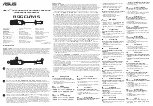
SCHOEPS
GmbH · Spitalstr. 20 · D-76227 Karlsruhe (Durlach) · Tel: +49 721 943 20-0 · Fax: +49 721 943 2050
www.schoeps.de · [email protected]
Applications
17
English
Applications
The CMIT 5 U is the ideal microphone for report-
ing, interviewing or dialogue for film and TV.
It is one of the very few shotgun microphones
in existence that can also be used as a spot
microphone for music recording, thanks to its
balanced frequency response and frequency-
independent polar pattern (with comparably
little difference between low and high fre-
quencies).
Sound is picked up along its axis:
Always make sure all of the slits in the tube
(sound inlet openings) are free and uncovered
when using the microphone. This is especially
important when using M/S or double-M/S tech-
niques requiring clips for mounting additional
microphones onto the CMIT 5 U. Covering
slits can alter the sound and directivity of the
microphone.
Here are some things which are worth knowing
about ”shotgun” microphones, including the
SCHOEPS CMIT 5 U:
1. For any given length of the interference
tube, a shot gun microphone's design can be
optimized for maximum directivity or for best
sound quality, but unfortunately not for both
at the same time. The SCHOEPS CMIT 5 U has
been optimized for best sound quality.
2.1 Room reflections and reverberance con-
tribute enormously to the character of any
sound. With a shotgun microphone, the pick-
up angle at high frequencies will be narrower
than at lower frequencies; as a result, diffuse
room sound will be picked up with a distinct
high-frequency rolloff, which can make the
sound rather dull. This tendency will be empha-
sized further if a windscreen is used. The ten-
dency toward dull sound can be counteracted
with a high-frequency boost, which can also
benefit speech intelligibility. The SCHOEPS
CMIT 5 U offers a built-in, switchable high-
frequency boost of this kind.
2.2 The polar patterns of shotgun micro-
phones often have multiple narrow lobes of
sensitivity. These can cause disturbing comb-
filter-like effects when the microphone (or a
sound source) is in motion, especially in indoor
recordings. Special care was taken to smooth
out these response lobes in the design of the
SCHOEPS CMIT 5 U.
2.3 Since any off-axis sound will be picked up
with reduced high-frequency content, a shot-
gun microphone must always ”track” (follow)
a moving actor or other sound source precisely
– particularly if the microphone is close to the
person being followed and / or its interference
tube is very long. Precise tracking is not always
easy, and even if it can be done perfectly, other
sound sources in the room (including noise
sources and other nearby voices) will still be
picked up from off-axis.
3. Since shotgun microphones are frequently
used out doors and / or on booms, they should
have a low-cut filter available to suppress wind
and handling noise. The SCHOEPS CMIT 5 U
has a switchable low-cut filter of this type.
In addition, any directional microphone will
increase its pickup of low and lower-midrange
frequencies when it is positioned near a sound
source. To avoid false boominess, a shotgun
microphone should also have a filter to com-
pensate for this ”proximity effect.” These two
requirements involve different frequency ranges
and different ideal filter slopes, however, so a
single low-cut filter is always a compromise at
best. The SCHOEPS CMIT 5 U has a switchable
low-cut filter with two different characteristics
available: a relatively sharp cutoff for suppress-
ing room rumble or wind and handling noise,
or a more gradual slope that reaches some -
what higher in frequency to compensate for
the proximity effect.
4. For high frequency sound, shotgun micro-
phones increase the distance at which a good
proportion of direct sound may be obtained.

































